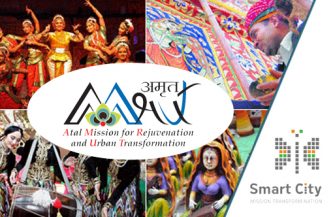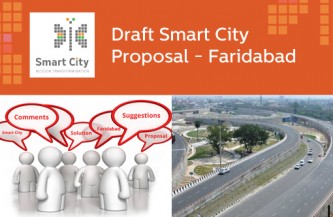Mera Shahar Mera Sapna Competition

Over the past year the term ‘Smart Cities’ has captured our collective imagination. Although the concept has been around for a while, it has gained tremendous interest in the Indian context after the Prime Minister articulated his Government’s vision for transforming Indian cities into world-class urban centers with unique heritage and distinguishing cultural values. The attention has spread beyond the borders of our cities and country with enthusiasm to create India’s ‘100 Smart Cities’coming from other countries and international private sector companies across sectors. Consultations, conferences, dialogues and meetings have been organized at all levels of government, the private sector and academia to discuss the concept of ‘Smart Cities’ and articulate strategies for delivering this important transformation.
Building on these discussions, and taking cognizance of the fact that the common man is the most important stakeholder in our cities, the Ministry of Urban Development organized the ‘Mera Shahar Mera Sapna’ competition in collaboration with MyGov and the National Institute of Urban Affairs (NIUA). The competition ran from 15 June 2015 to 20 June 2015. The objective of the competition was to encourage citizens to contribute their ideas and solutions for addressing challenges faced by Indian cities. The format posed 14 questions related to city-level challenges, possible solutions and innovative ideas with a limit of250 words to answer each question. In order to be eligible for a prize, participants were required to answer all the questions in at least one of the following three categories.
- Common Solutions for all cities (694 entries published)
- Smart Solutions for traffic problems (645 entries published)
- Use of Information Technology to improve Governance services (316 entries)
The questions varied from soliciting strategies to reduce traffic congestion outside one’s home to ideas for reducing the gap between the rich and poor to conceptualizing applications of big data and IT for improving municipal governance. Aimed at understanding the common man’s hopes and aspirations for their city, some of the questions were also aimed at gathering information and valuable clues into what India wants to see in its cities. For instance one question asked participants to choose the top 3 solutions (out of a list of 21) that must be prioritized in Indian cities while another asked for a listing of 3 municipal services that can be improved using mobile phones. With the hope of involving the most important stakeholder in our cities the competition was launched on 15 June 2015.
Simply put, the response was excellent! Within five days, the website received over 1000 posts across the three different categories. By the end of the week there were 1733 submissions. While the number of entries was high their quality was equally impressive. Strikingly, though not surprisingly, nearly all entries had a sincere or meaningful contribution.
The initial screening quickly revealed that there were several outstanding entries in the mix. The jury members were both amazed and appreciative in equal measure. There were also several innovative ideas within individual entries that caught the eye. For example one solution for addressing traffic woes was to embed technologies for solar powered generation within the road infrastructure as a means for providing charging points for electric vehicles and powering congestion management sensors. Some solutions were fanciful but many were practical, sensible and thoughtfully directed at addressing challenges such as Safety and Security and Improving Public Buses or just leveraging IT for better governance. The jury was impressed to see ideas for improving health and awareness in urban areas through solutions such as monitoring electromagnetic radiation in cities, using IT to raise awareness of better health practices and leveraging big data to study patterns of vector borne diseases and localize responses. Not limited to technology and hardware solutions, the participants showed a strong awareness of the importance of improving softer aspects of city governance. Setting a minimum wage to address poverty and improve dignity, improving access to schools for the urban poor and improving working conditions for municipal employees were common themes in entries in the category Common Solutions for all Cities.

However, this was a competition and the task at hand was to choose one winner. Entries that did not adhere to the rules (answer all questions in a category within the word limit) were scrutinized carefully for innovative ideas before screening them out. Thereafter, responses were given marks against two criteria ‘Do-Ability’ and ‘Innovation’ to strike a balance between creativity and practicality. The top 10 answers in each category were selected for the final round. These entries were carefully examined and extensively discussed by the jury before finalizing the top two winners in each category. The winners in each category were
1st Prize – Shravan Shankar
2nd Prize – Nisha Mary Poulose
1st Prize – Sharad Mohindru
2nd Prize – Kumresh Kumar Sharma
1st Prize – Rajan Kumar Dubey
2nd Prize – Jayesh Vani
Their ideas stood out for their relevance to the Indian context and for having a clear distinguishing feature, such as cost effectiveness, innovative financing, inclusivity or a clever application of existing tools. For instance, one of the eventual winners in the Category – Use of IT to improve Governance services – identified the integration of CCTV technology, the Internet and heritage or monument sites as a solution for improving safety and security in public places while providing better quality educational information to visitors. Similarly, linking tax deductions to the use of public transport (by linking PAN information to Smart Cards) was as an interesting approach suggested by another participant to incentivize the use of public transport. Providing skill training, education and nutritious food along with urban design to give space to the poor on roadswas a identified as a thoughtful and humane approach towards building ‘Smart Cities’ that are also inclusive cities. Even though there were multiple entries with similar ideas, the winners followed the rules of competition and gave equal emphasis to practicality and innovation.
Moving forward, this collection of posts and entries will be useful to the Ministry of Urban Development in identifying the most popular ‘keywords’, solutions and problems that the contestants mentioned in their entries. A strong and consistent theme in the entries in Common Solutions for all Cities suggested that citizens want their cities to prioritize ‘Waste to Wealth’, ‘Recycling of Water’ and ‘Sustainable Energy’. Decreasing the time required for delivering public services, a citizen charter with specific turnaround times or at the very least letting people know the exact status of their request (for birth certificates, registration of property, renewal of licenses etc.) were some of the challenges that people enthusiastically addressed in the category focused on IT for better governance. In the area of traffic management, it was refreshing to see that a significant number of entries suggested that car ownership should be restricted on the basis of households.
The answers also provide a resource base for ideas that can guide city governments in developing their project proposals for the 100 Smart Cities mission launched by the honorable Prime Minister. One such simple smart idea was developing a ‘Department Rating App’ where citizens can rate government offices and agencies for efficiency in delivering services and share their experience with the wider public.
For the organizers of this competition, the contest was also an example of collaboration between different government departments and agencies to encourage participation by people. We hope that such collaboration will also become a common theme between various agencies and stakeholders acting and active in our cities. The ‘Smart Cities Mission’, we are confident, will provide opportunities to test and apply the ‘smart ideas’ that emerged from the ‘Mera Shahar Mera Sapna’ competition.





